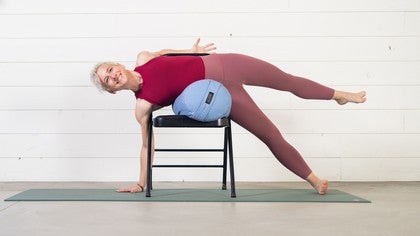
Prop Up Your Arm Balances with Props
Props play a quintessential role in learning, experiencing, and mastering arm balancing. By supporting the body, you can feel what flight is like. You can embody the shape and learn the actions necessary to successfully arm balance. Props give you the permission and freedom to explore while dispelling fears of falling or feeling weak.
Since there are multiple setups you can use in arm balancing, props also reveal what we need to focus on in our practice. In the case of Bakasana, or Crane Pose, you might breeze through setups that require accessing hip and knee flexion, but then you might encounter challenges lifting your feet. This gives you information as to where you want to focus your energy when entering the position in your subsequent practices.
If we remain under the guise that practicing with props is less-than, then we run the risk of discounting a valuable part of the asana, or physical yoga practice. In fact, by reducing some of the load, stress, and struggle, you can confidently explore arm balances and simultaneously build targeted strength with continued practice. A ton of Planks and Chatturanga's (four-limbed staff pose) do translate into building strength, but are not as precise to specifically address strength in the specific arm balance. This is because, in the previous example of Bakasana, the lower body position is vastly different in the arm balance than in Chatturanga.
Even yogis who regularly practice arm balances benefit from adding props to their arm balance practice. I’ve found it tremendously useful in my yoga practice to use a lot of props to support my body in arm balances even though I can practice without them too. In this case, my arm balance practice remains strong while I expend less energy. So it’s important to keep in mind that just because you can practice without props, it doesn’t mean that you shouldn’t include them.
And let’s not forget about the fun factor! Not only do props offer you a new perspective in your asana practice by making balancing on your hands easier, you can also play with the different types of support you can use for each arm balance. Be creative with your specific setups for your body and literally play games! You can create prop playgrounds to practice in, for example playing with picking up and lowering a block between your feet in Bakasana. These challenges are stimulating for your brain and practice which ultimately will strengthen your dedication to come back to the practice. After all, if all you feel is weak, frustrated, and stuck, do you really want to repeat that experience time and time again in your practice? Of course not, and I’m with you on that one!
This is what my new show on Yoga Anytime, Discover Arm Balancing, explores. We move through different iterations of Vasisthasana, or Side Plank, in a fun and supported way. Each episode explores a new variation of Vasisthasana and also supports the work practiced in each prior episode so that you incrementally become stronger, more confident, and more adventurous in this arm balance.
So, grab your props, hop on your mat, and discover the land of arm balancing that awaits you.
Comments

You need to be a subscriber to post a comment.
Please Log In or Create an Account to start your free trial.








